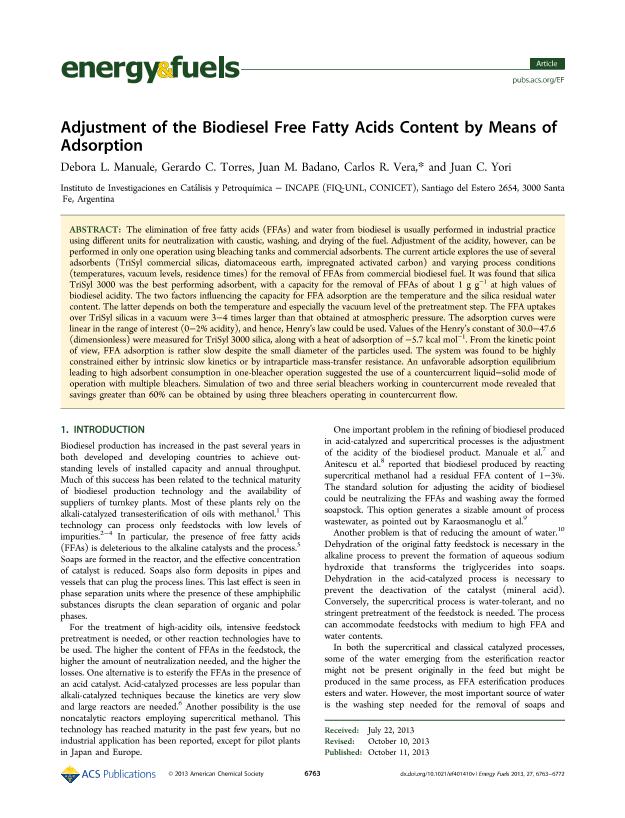Artículo
Adjustment of the Biodiesel Free Fatty Acids Content by Means of Adsorption
Manuale, Débora Laura ; Torres, Gerardo Carlos; Badano, Juan Manuel
; Torres, Gerardo Carlos; Badano, Juan Manuel ; Vera, Carlos Roman
; Vera, Carlos Roman ; Yori, Juan Carlos
; Yori, Juan Carlos
 ; Torres, Gerardo Carlos; Badano, Juan Manuel
; Torres, Gerardo Carlos; Badano, Juan Manuel ; Vera, Carlos Roman
; Vera, Carlos Roman ; Yori, Juan Carlos
; Yori, Juan Carlos
Fecha de publicación:
10/2013
Editorial:
American Chemical Society
Revista:
Energy & Fuels (print)
ISSN:
0887-0624
Idioma:
Inglés
Tipo de recurso:
Artículo publicado
Clasificación temática:
Resumen
The elimination of free fatty acids (FFAs) and water from biodiesel is usually performed in industrial practice using different units for neutralization with caustic, washing, and drying of the fuel. Adjustment of the acidity, however, can be performed in only one operation using bleaching tanks and commercial adsorbents. The current article explores the use of several adsorbents (TriSyl commercial silicas, diatomaceous earth, impregnated activated carbon) and varying process conditions (temperatures, vacuum levels, residence times) for the removal of FFAs from commercial biodiesel fuel. It was found that silica TriSyl 3000 was the best performing adsorbent, with a capacity for the removal of FFAs of about 1 g g–1 at high values of biodiesel acidity. The two factors influencing the capacity for FFA adsorption are the temperature and the silica residual water content. The latter depends on both the temperature and especially the vacuum level of the pretreatment step. The FFA uptakes over TriSyl silicas in a vacuum were 3–4 times larger than that obtained at atmospheric pressure. The adsorption curves were linear in the range of interest (0–2% acidity), and hence, Henry’s law could be used. Values of the Henry’s constant of 30.0–47.6 (dimensionless) were measured for TriSyl 3000 silica, along with a heat of adsorption of −5.7 kcal mol–1. From the kinetic point of view, FFA adsorption is rather slow despite the small diameter of the particles used. The system was found to be highly constrained either by intrinsic slow kinetics or by intraparticle mass-transfer resistance. An unfavorable adsorption equilibrium leading to high adsorbent consumption in one-bleacher operation suggested the use of a countercurrent liquid–solid mode of operation with multiple bleachers. Simulation of two and three serial bleachers working in countercurrent mode revealed that savings greater than 60% can be obtained by using three bleachers operating in countercurrent flow.
Palabras clave:
Biodiesel
,
Adsorbents
,
Free Fatty Acids
Archivos asociados
Licencia
Identificadores
Colecciones
Articulos(INCAPE)
Articulos de INST.DE INVEST.EN CATALISIS Y PETROQUIMICA "ING. JOSE MIGUEL PARERA"
Articulos de INST.DE INVEST.EN CATALISIS Y PETROQUIMICA "ING. JOSE MIGUEL PARERA"
Citación
Manuale, Débora Laura; Torres, Gerardo Carlos; Badano, Juan Manuel; Vera, Carlos Roman; Yori, Juan Carlos; Adjustment of the Biodiesel Free Fatty Acids Content by Means of Adsorption; American Chemical Society; Energy & Fuels (print); 27; 11; 10-2013; 6763-6772
Compartir
Altmétricas



